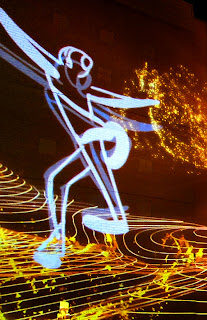 |
| Light was wonderful but finding a vantage point was a challenge. A point and shoot met the challenge. |
News shooters know this trick. Often, when caught inside a tight scrum of photographers, they do the only thing possible. They hold their cameras above their heads and they shoot blind.
At least, this is what they did two decades ago. Today, with monitors on camera backs that flip out and even possibly rotate, it is no longer so imperative that one keeps one's eye to the viewfinder.
For more than four decades I was a news shooter. I learned to hold my camera high above my head and shoot with film and with trust. When I got my first point and shoot, a Canon SD10, I found I had a camera that did not have a viewfinder and the monitor could not be viewed in bright sunlight.
I'll admit that I thought I was snookered. I confess that at first I hated that camera. Unfortunately it was a gift from my wife. Returning it was not an option.
 |
| Red sketch indicates camera position. |
The other day I saw my three-year-old granddaughter doing a Dora puzzle. She was facing a living room window, the light was wonderful, the moment memorable but there was no way I could get into position for the picture. If I took the time to move the plant and pot sitting just where I wanted to be, the moment would be lost.
I sat down, hung my arm over the edge of the sofa, and with my hand almost at floor level, I started shooting and shooting and shooting some more. Exposing digits is cheap. The constraints of expensive film are concerns from yesterday.
My Canon S90 doesn't have a flip out monitor, but it does have an f/2.0 lens at wide angle (28 mm). And it can be set to take a lot of pictures in a hurry. It may be an amateur point and shoot, but it is a pro at handling focus concerns and exposure calculations.
I shot lots and I got a picture with lots to like. I also got lots not to like, but that's O.K. Talk and digits are cheap. Good pictures are priceless.
Learn to shoot blind. It'll open your eyes.




